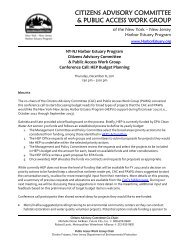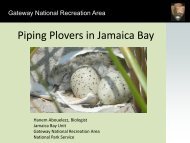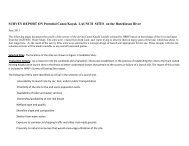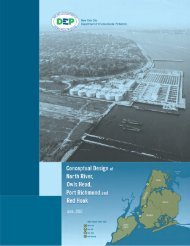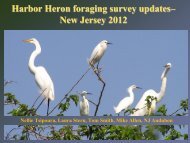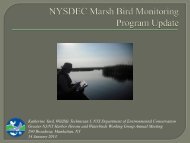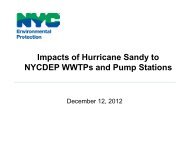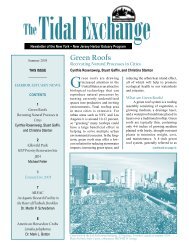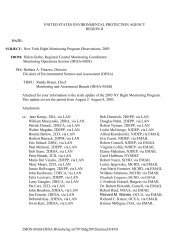A Model for the Evaluation and Management of Contaminants of ...
A Model for the Evaluation and Management of Contaminants of ...
A Model for the Evaluation and Management of Contaminants of ...
Create successful ePaper yourself
Turn your PDF publications into a flip-book with our unique Google optimized e-Paper software.
levels <strong>of</strong> contaminants <strong>of</strong> concern in <strong>the</strong> biota (Macoma sp., Nereis sp., <strong>and</strong><br />
o<strong>the</strong>r species selected <strong>for</strong> modeling).<br />
• <strong>Model</strong> simulations <strong>of</strong> <strong>the</strong> interactions <strong>of</strong> “hot-spot,” in-place, contaminated<br />
sediments with water, sediment <strong>and</strong> biota <strong>of</strong> <strong>the</strong> Estuary. The goal <strong>of</strong> <strong>the</strong>se<br />
scenarios will be to evaluate <strong>the</strong>se selected Harbor areas as contaminant sources<br />
to o<strong>the</strong>r areas <strong>of</strong> <strong>the</strong> Harbor <strong>and</strong> to evaluate <strong>the</strong> burial or fur<strong>the</strong>r contamination <strong>of</strong><br />
<strong>the</strong>se sediments in <strong>the</strong> future.<br />
• Time History/projections <strong>for</strong> improvements in newly deposited sediment quality<br />
after <strong>the</strong> simulated contaminant reductions are made or dredging is conducted,<br />
as specified above. Of particular interest is <strong>the</strong> minimum timeframe required <strong>for</strong><br />
a reduction in <strong>the</strong> amount <strong>of</strong> contaminated dredged material to 15% by <strong>the</strong> year<br />
2040.<br />
Task 1-8: Develop a windows-based user interface <strong>for</strong> simulating additional scenarios with<br />
both <strong>the</strong> chemical fate <strong>and</strong> bioaccumulation models. This interface will<br />
incorporate <strong>the</strong> calibrated fate <strong>and</strong> transport models, <strong>and</strong> provide windows<br />
dialog boxes <strong>for</strong> prescribing alternate combinations <strong>of</strong> external loads <strong>and</strong><br />
species-specific parameters (e.g., % lipid, age class, trophic level, egestion <strong>and</strong><br />
excretion rates, etc.). Also, a post-processor will be developed to store <strong>and</strong><br />
display <strong>the</strong> model results in a GIS-compatible <strong>for</strong>mat.<br />
Task 1-9: Develop a modeling approach to evaluate sediment toxicity. Many <strong>of</strong> <strong>the</strong><br />
sediments <strong>of</strong> New York Harbor have been shown to exhibit unacceptable toxicity<br />
to amphipods (Ampelisca sp.) through laboratory testing. While <strong>the</strong> causes <strong>of</strong><br />
<strong>the</strong> toxicity have yet to be specifically linked to any particular contaminant or<br />
suite <strong>of</strong> contaminants, research results from this region <strong>and</strong> from o<strong>the</strong>r systems<br />
may be useful in <strong>for</strong>mulating conceptual <strong>and</strong> ma<strong>the</strong>matical models <strong>of</strong> toxicity.<br />
For instance, narcosis based upon PAH contamination may be a way <strong>of</strong><br />
evaluating <strong>and</strong> predicting toxicity.<br />
VIII.<br />
Tier-2 <strong>Model</strong>ing Tasks<br />
As noted above, <strong>the</strong> goal <strong>of</strong> <strong>the</strong> Tier-2 modeling ef<strong>for</strong>t will be to develop explicit, finer-scale<br />
models that couple hydrodynamics, water quality, <strong>and</strong> sediment transport, <strong>and</strong> that can be<br />
used to guide <strong>and</strong> implement geographically specific reduction strategies <strong>and</strong> dredged<br />
material management. Because <strong>the</strong>re may be several viable approaches to achieve this<br />
goal, <strong>the</strong> Tier-2 tasks will be more open-ended than Tier-1 tasks. Never<strong>the</strong>less, all<br />
possible approaches should build on existing knowledge <strong>and</strong> databases.<br />
Task 2-1: Develop a Tier-2 model(s) that includes <strong>the</strong> following fully linked components <strong>and</strong><br />
qualities:<br />
• Water Quality <strong>Model</strong> (including carbon kinetics)<br />
• Hydrodynamic <strong>Model</strong>: updatable to take into account changes in Harbor<br />
15




